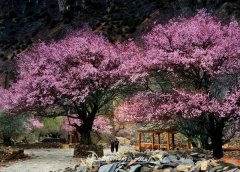
World's Biggest Buddhist Academy

Panorama of Larung Gar Buddhist Academy in Laroung valley
Larung Gar Buddhist Academy, also known as Larung Five Sciences Buddhist Academy, is believed to be the world’s largest Buddhist institution. Over 20 kilometers southeast to Sertar County, Garze Prefecture, Sichuan Province, lies the Larung Gar Buddhist Academy. The Buddhist institution was originally founded by Khenpo Jigme Phuntsok in 1980. Since then, the original tiny Buddhist school with no more than 30 disciples has grown into a massive Buddhist institution, boasting approximately 40,000 students.
Unlike the usual Tibet Tours in Tibet Autonomous Region, for years, a sizeable number of travellers have been drawn to visit this secluded realm of spirituality. And the majority of them come for two reasons: one is for photography and the other is to experience the overwhelming journey of spiritual discovery.
Incredible place for Photography

Countless red cabins built on the ridge of the mountains
To photographers, the massive Buddhist settlement embedded in Laroung valley and devout Buddhist monks, nuns offer a superb subject for landscape and portrait photography. As you enter this gigantic Buddhist academy (or let’s say it’s more like a huge religious community), no one will not be amazed by grand view that numerous densely built red cabins radiate miles away from the central Buddhist academy in Laroung Valley. In fact, these small cabins are the residence for Tibetan monks, nuns and lay disciples.
Small as they are, a number of exquisite temples and monasteries dominate the bottom of the valley and the ridge of the mountain. Every so often, lamas or Jo-mas (or female lamas), dressed in red cotton robes are seen travelling back and forth among alleys of the enormous Buddhist community, with air peppered with the scent of incense and harmonious atmosphere.

The awe-inspiring sunset in Larung Gar Buddhist Academy
The best time to take the panorama of the entire Buddhist settlement is at twilight. You can cross the residence of nus to reach the mountaintop (at an altitude of around4200m) where it would be the best place to snap photos. Do remember to take winter down jacket, because even if it is in summer, the temperature could be bitterly cold at night.A 24-70mm lens or even a wide angle zoom lens like 14-24mm would be perfect and versatile for such big shot. Besides, the travelling male and female lamas are also preferable subjects for shooting. One thing to bear in mind is to respect them and take pictures at a proper distance.
A Journey of Spiritual Discovery

A lovely nun smiles towards the camera.
In addition to bringing back a heavy loads of stunning pictures, more people come to witness, to feel, to be touched, and even to find answers, etc. via this spiritual journey. Each day, the remote valley will greet ceaseless flow of pilgrims, disciples and lay practitioners from the globe to visit and study here. Some are highly educated and have unusual wisdom in studying Buddhism. Among these people, many stay here for a couple of weeks, while some even live and study here for over 10 years or for the rest of their life.

Nuns and a little monk walk together.
The systematic Tibetan Buddhism study falls into long-term and short-term categories. Normally, a long-term study lasts for 6 years while for some special degrees it could be as long as 13 years. Students have to pass both written and spoken defense just like the secular higher education institutes. Monks and nuns study and live separately and there is no TV or toilet in their rooms. Yet, the vibrant study atmosphere and harmonious life can be felt and seen everywhere in this sacred academy.
Travel tips:
a. When taking phots of monks in Larung Gar Buddhist Academy, you’d better keep a long distance and if you want to take pictures with them, do respect and ask for permission first.
b. Normally, visitors are forbidden to watch the Sky Burial, in which the dead bodies are chopped into pieces for vultures.
c. The living condition is rather humble and very basic. Do take sleeping bags and necessary toiletries if necessary.
d. Given the high altitude (around 4100m), do take down jacket, sunglass, fleece wind-Stopper jacket, sunscreen, fleece hat, etc. Do pay special attention to the huge temperature between day and night.
e. It’s advisable to bring Aspirin, and other necessary medicines for altitude sickness and motion sickness, cold relief, diarrhea, etc. under the guidance of doctors.
f. In addition to keeping warm, the red color of your outfit would be preferred for photography.
g. Never move or run abruptly on high plateau, because the shortage of oxygen means extra burden to your body. Drink more water and veg, keep warm and sleep tight.
Please feel free to check other recommended China and Tibet Tour

Energetic, responsible and reliable, Sonam is a guide with more than seven years experience informing visitors about heritage sites and attractions places in Tibet.
Related Articles & Posts

Latest Tibet Travel News

Tibet Vista: A Social Responsible Tour Organizer
Aug 14,2023

Tibetan Monks Debate in Drepung Monastery
Jun 10,2023

Tips for Traveling to Tibet in Spring
Feb 17,2022

Snow Will Hit Qinghai-Tibet Plateau
Feb 17,2022


.jpg)




0 Comment ON "World's Biggest Buddhist Academy"